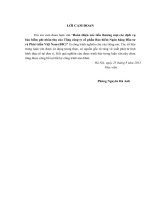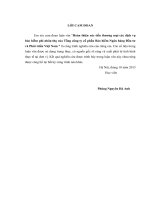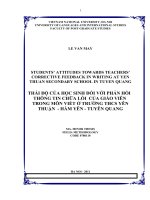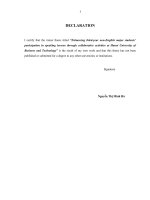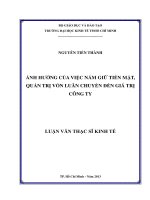Luận văn thạc sĩ tiếng anh trường ngoại thương
Bạn đang xem bản rút gọn của tài liệu. Xem và tải ngay bản đầy đủ của tài liệu tại đây (527.76 KB, 84 trang )
THE CERTIFICATION
I hereby certify that the thesis with the title: "The Impact of TPP on Vietnam's
Financial Services" is my own research and does not reproduce any other materials.
The data indicated in the thesis is clear, accurate and collected from the confident
sources of information.
The Author
Nguyen Thi Anh Tuyet
TABLE OF CONTENTS
THE CERTIFICATION ................................................................................................... 1
TABLE OF CONTENTS .................................................................................................. 2
LIST OF ABBREVIATIONS .......................................................................................... 4
LIST OF CHART AND TABLES ................................................................................... 6
PREFACE ........................................................................................................................... 1
CHAPTER 1 ....................................................................................................................... 8
THE OVERVIEW OF FINANCIAL SERVICES. ....................................................... 8
1.1.
The definition, characteristics and classification of financial services. ......... 8
1.2.
The roles of financial services in an economy. ................................................. 14
1.3.
The factors affecting financial services ............................................................. 16
CHAPTER 2 ..................................................................................................................... 19
THE OVERVIEW OF THE TPP AND THE KEY REGULATIONS OF THE
TPP ON FINANCIAL SERVICES. .............................................................................. 19
2.1.
The overview of the TPP. .................................................................................... 19
2.2.
The key TPP regulations on financial services. ............................................... 21
CHAPTER 3 ..................................................................................................................... 32
THE IMPACT OF THE TPP ON BANKING SERVICES IN VIETNAM ........... 32
3.1.
The current situation of banking services in Vietnam. .................................. 32
3.2.
Some main impacts on the banking services of Vietnam under the TPP. ... 39
CHAPTER 4 ..................................................................................................................... 48
THE IMPACT OF THE TPP ON INSURANCE SERVICES IN VIETNAM ...... 48
4.1.
The current situation of insurance services in Vietnam................................. 48
4.2.
Some main impacts on the insurance services of Vietnam under the TPP. 50
CHAPTER 5 ..................................................................................................................... 59
RECOMMENDATIONS AND CONCLUSIONS. ..................................................... 59
5.1. Recommendations to develop financial services in Vietnam if the TPP
enters into force................................................................................................................ 59
5.2.
Conclusions............................................................................................................ 71
REFERENCES................................................................................................................. 75
LIST OF ABBREVIATIONS
Abbreviations
The full name/description.
AEC
Asian Economic Community
Agribank
Bank for Agriculture and Rural Development of Vietnam
ATMs
Automated Teller Machines
BIDV
Joint Stock Commercial Bank for Investment and Development of
Vietnam
BIN
Bank Identification Number
CBD
Cross-border Trade
FBs
Foreign Banks
FDI
Foreign Direct Investment
FTAs
Free Trade Agreements
GATS
The General Agreement on Trade in Services
IAIS
International Association of Insurance Supervisors
IBPS
Interbank Payment System
ISDS
The Investor-State Dispute Settlement
JSCBs
Joint Stock Commercial Banks
JVBs
Joint Venture Banks
M&A
Mergers and Acquisitions
MA
Market Access
MFN
Most-favored nation treatment
MST
The Minimum Standard of Treatment
NPLs
Non-performing loans
NT
National treatment
POSs
Points of Sales
SBV
State Bank of Viet Nam
SMBDs
Senior Management and Boards of Directors
SOCBs
State-owned Commercial Banks
SOEs
State-owned Enterprises
TPP
Trans-Pacific Partnership
VAMC
Vietnam Asset Management Company
Vietcombank
Joint Stock Commercial Bank for Foreign Trade of Vietnam
Vietinbank
Vietnam Joint Stock Commercial Bank for Industry and Trade
LIST OF CHART AND TABLES
Order No.
The name of chart or tables
Page
Chart No.2.1
The number of the commercial banks in Vietnam in the period of 39
1991-2015.
Table No.2.1
The number of Viet Nam’s insurance firms from 2011 to 2015
44
Table No.2.2
The premiums and total assets of Viet Nam’s Insurance 46
companies from 2011 to 2015
Table No.2.3
The distribution channel of insurance services
57
1
PREFACE
1. Introduction.
Finance is central to the functioning of the economy as a whole. Finance has
distinct attributes, presents distinct risks, and has long been regulated in distinct
ways that are hard to accommodate in a framework that applies to service and
investment in general (Anna Gelpern, 2016). For this reason, the governments
always seem to be cautious when they undertake their commitments on financial
services in the framework of any FTA. In other words, almost of them have
preferred nonbinding, informal commitments to the enforcement machinery of
international trade law.
The Trans-Pacific Partnership Agreement (TPP) is a new generation FTA, not
just focusing on the liberalization of trade in goods but also covering services,
intellectual property right (IPR), SPS, TBT and other relevant issues. Financial
services are also a big concern of the TPP member countries. They get their own
chapter in the TPP and are regulated in some other chapters such as chapters on
cross-border trade, investment and dispute settlement.
In comparison with the General Agreement on Trade in Services (GATS) in
the framework of WTO, the TPP commitments on financial services have some
different features.
The TPP contains the cooperation between the further market openness and
the investment protection. It means that the subject matter and the scope of the TPP
commitments on financial services are expanded, which are accompanied with the
additional obligations relating to investment protection such as the Minimum
Standard of Treatment (MST) and ISDS mechanism. These obligations bring the
benefits to foreign investors, but the challenges to the local providers of financial
services and the host countries.
Moreover, the TPP approach of negative list is usually applied to developed
countries whose liberalization in trade and investment is at high level and legal
2
system has fully improved. The approach is really a challenge to developing
countries like Vietnam whose finance market is in the stage of ongoing
development and is significantly different from developed countries.
In addition, the Ratchet mechanism is also an obstacle to Vietnam. According
to the mechanism, the amendment of reservation measures, namely the nonconforming measures, and the level thereof will become binding the level of
liberalization. In other words, the level of liberalization in the TPP members will be
more and more higher, but not lower.
Along with the approach of negative list, the commitments on cross-border
trade and the obligations of providing licenses to new financial services are also
difficulties for Vietnamese providers of financial services because of their poor
capacity of competitiveness in comparison with the rivals from the other TPP
member countries.
In the theoretical aspect, the high level of liberalization in the framework of
the TPP will give the providers of the TPP member countries in general and
Vietnam in particular many opportunities to further get market access abroad.
Accordingly, all TPP member countries can get benefits from the TPP. However, in
order to take advantages of these benefits, Vietnam will face some challenges as
above-mentioned. Therefore, assessing the likely impact of the TPP commitments
on financial services, understanding the challenges and taking advantages of the
opportunities are vital problems to the local providers in building their business
strategies and to government authorities in making policies to develop markets for
financial services.
For the above reasons, my thesis will focus on the topic namely “The impact
of TPP on Vietnam’s financial services”.
According to GATS and TPP, the financial services include (i) insurance and
insurance-related services and (ii) banking and other financial services. Moreover,
the financial services existing in Vietnam are mainly in the banking and insurance
sector. Therefore, the thesis will study on these two big sectors of financial services
in Vietnam since 2010 when Vietnam began to take part in the process of
3
negotiating the text of the TPP. The subjects of the thesis are the possible impact of
the TPP on insurance services and banking services in Vietnam and
recommendations to develop these services.
The thesis will aim at the situation of the two typical sectors of financial
services in Vietnam, estimate the possible impact of the TPP thereon and relevant
trends, propose recommendations to develop these services in Vietnam. In order to
reach the purpose, the thesis will concentrate on the following missions:
- Researching the theoretical basis for financial services and the TPP
regulations thereon in comparation with the corresponding regulations of Vietnam.
- Finding out the current situation of banking and insurance services in
Vietnam and estimating the possible impact of the TPP on these services if the TPP
enters into force.
-
Forecasting the
relevant trends, proposing the
directions and
recommendations of development of these services in Vietnam.
2. Literature review
The TPP is the subject of many studies of foreign scholars and experts. These
include some studies as follows:
This volume named “Trade Implications of the Trans-Pacific Partnership for
ASEAN and other Asian countries” by Alan V.Deardorft (2013) have studied the
possible impact of the TPP on a list of countries in terms of trade creation, trade
diversion, and the reversal of trade diversion that has already occurred due to
existing FTAs. The list of countries contains all of the members of the TPP as well
as of ASEAN and also includes ten additional Asian economies that are not part of
either. This volume provided the description of the TPP, its trade effects and
discussion on whether the TPP might be expected to benefit or harm the economies
of the TPP, of ASEAN, and of selected other Asian countries. In brief, the volume
have emphasize on the impact of the TPP on an economy as a whole, but not on a
specific industry sector.
This report named “Trans-Pacific Partnership Agreement: Likely impact on
the US economy and specific industry sectors” by U.S International Trade
4
Commission (2016) assesses the possible impact of the TPP on the U.S. economy as
a whole and on specific industry sector. It comprises the TPP’s impact on the
United States’ gross domestic product, exports, and imports; U.S. aggregate
employment and employment opportunities; the production, employment, and
competitive position of U.S. industries likely to be significantly affected by the
TPP; and the interests of U.S. consumers. The report also reviews other assessments
of the TPP’s economic effects available in the literature, and discusses areas of
consensus and divergence between the Commission’s analyses and conclusions and
those in the literature reviewed. The financial services are subject matters of the
Chapter 5 named “Impact of the TPP on trade in services”. The chapter focused on
the potential impact of the TPP on the financial services of the United States.
The book named “Trans-Pacific Partnership: An assessment”, edited by
Jeffrey J.Schott and Cathleen Cimino-Isaacs, showed an in-depth, comprehensive
analysis of the potential economic impact of the TPP. The authors of the book
analyze the traditional market access aspects of the agreement as well as assess
innovations in trading rules, drawing out the implications for governments,
businesses, workers, and households. This book includes a comprehensive analysis
of the macroeconomic and sectorial effects of the TPP, which demonstrates that the
TPP will deliver large economic benefits to the United States and its trading
partners. Financial services get the own chapter in this book written by Anna
Gelpern. This chapter provides the overview of obligations and commitments as
stated in Chapter 11 of the TPP. It also analyzes in detail the obligations of NT,
MFN, and MA, the minimum standard of treatment, the ISDS mechanism, and the
prudential measures. This chapter also indicated innovative or new regulations
stated in the TPP on financial services that have not included in previous FTAs yet.
There are some books of Vietnamese authors on the TPP like “Hiệp định Đối
tác Xuyên Thái Bình Dương-TPP và vấn đề tham gia của Việt Nam”- In English:
“the Trans-Pacific Partnership Agreement –TPP and Vietnam’s participation
issues”- by Prof. Dr. Hoang Van Chau and some teachers from the Foreign Trade
University of Hanoi or “Hiệp định Đối tác Xuyên Thái Bình Dương (TPP) và tác
5
động tới Việt Nam”- In English: “the Trans-Pacific Partnership Agreement (TPP)
and its impact on Vietnam”- by Prof. Dr. Nguyen Anh Tuan.
This book, namely “Hiệp định Đối tác Xuyên Thái Bình Dương (TPP) và tác
động tới Việt Nam”- In English: “the Trans-Pacific Partnership Agreement –TPP
and Vietnam’s participation issues”, provided the overview of the content of the
negotiations of the TPP, analyzed the obstacles of the negotiations and the purpose
of the participation of the 12 member countries. Especially, the book assessed the
potential impact of the TPP on the region and the world in general, on Vietnam and
its process of international integration in particular, accordingly estimating the
development trends of the Vietnamese economy in the next future, proposing
recommendations to restrict challenges and take advantages of benefits.
This book, namely “Hiệp định Đối tác Xuyên Thái Bình Dương-TPP và vấn
đề tham gia của Việt Nam” ”- In English: “the Trans-Pacific Partnership Agreement
–TPP and Vietnam’s participation issues”, introduced the overview of the TPP as
well as its role in the world economy and the purpose of the member countries. The
book also analyzed the opportunities and challenges to Vietnam when Vietnam
becomes a full member of the TPP. The analysis included the assessment on
financial services. They have emphasized on the new commitments of the TPP on
financial services which are different from the WTO commitments.
Within the scope of Vietnam’s master theses, there are some theses of students
from the Foreign Trade University of Hanoi researching on this topic such as “The
Trans-Pacific Partnership (TPP): Opportunities and Challenges for Vietnam” by
Dinh Hoang Anh (2015), “Thương mại dịch vụ trong Hiệp định TPP và vấn đề đặt
ra đối với Việt Nam” –In English:“Trade in services according to the TPP and some
matters to Vietnam”- by Tran Thi Diem Chau (2014) and “Cơ hội và thách thức đối
với ngành Ngân hàng khi Việt Nam tham gia Hiệp định TPP”- In English:
“Opportunities and challenges for Vietnam’s banking system when Vietnam have
took part in TPP” - by Nguyen Thi Tra Giang (2014).
Some of these documents analyzed the TPP’s effects on the whole economy,
but not on a specific industry sector. There are some volumes which have
6
mentioned in financial services in the United States and other countries but not in
Vietnam. Moreover, almost of them did not show Vietnam’s present situation or did
not reflect all the updated text of the TPP because they were published before the
TPP’s negotiations were concluded.
For these reasons, in this thesis, I will focus on studying on Vietnam’s
financial services with two main sectors such as banking and insurance under the
likely impact of the TPP commitments stated in its latest and formal text, analyze
possible opportunities and challenges and then propose recommendations in order
to protect and support the development of Vietnam’s financial services.
3. The research questions.
The thesis will answer to the following research questions:
-
What is the definition of term “financial services”, its roles in an
economy and which factors influence on financial services?
-
Which key features does the TPP have?; what is the scope of the TPP?
Which are the TPP commitments and obligations on financial services? What about
the non-conforming measures of Vietnam on financial services?
-
How about the current situation of the banking services in Vietnam?
How does the TPP impact on the banking services in Vietnam?
-
How about the current situation of the insurance services in Vietnam?
How does the TPP impact on the insurance services in Vietnam?
-
What are recommendations for preventing the negative impact and
supporting the development of the banking and insurance sectors of Vietnam?
4. The research methodology.
I have researched the theoretical aspects of financial services and the TPP
commitments and obligation on financial services. I also have analyzed new issues
in framework of the TPP which have not existed in the FTAs in which Vietnam has
previously participated, for example: the negative list approach and the Ratchet
mechanism. These analyses are in the content of Chapter 1 and Chapter 2.
In Chapter 3 and Chapter 4, I have studied the current situation of two main
sectors of financial services which are typically financial services in Vietnam,
7
namely banking and insurance services. In comparison with the present situation of
two sectors and the above analyses stated in Chapter 1 and 2, I have accordingly
evaluated the possible impact of the TPP on the two sectors in such aspects as
policies, regulations and laws, modes of providing services, types and market of
services, providers.
Based on the content of Chapter 3 and 4, I have proposed some
recommendations in order to limit the negative effects and promote the
development of the two sectors in Vietnam.
5. The expected results of the thesis
The thesis began to be written after the negotiations of the TPP have
concluded. At present, 12 member countries begin the next steps of reviewing the
domestic laws and preparing for the ratification of the TPP. Therefore, the thesis
will bring the following results:
- Analyzing the formal text of the TPP regulations on financial services and
comparing them with the corresponding regulations of Vietnam.
- Evaluating the current situation of the banking and insurance services in
Vietnam and estimating the possible impact of the TPP on them if the TPP enters
into force.
- Suggesting the directions of development of these services in Vietnam and
the corresponding recommendations in the context of TPP coming into effect.
8
CHAPTER 1
THE OVERVIEW OF FINANCIAL SERVICES.
1.1. The definition, characteristics and classification of financial services.
1.1.1. The definition of financial services
In order to understand the definition of financial services, it is essential to be
aware of the definition of services.
Under the Vietnamese dictionary published in 2000 by the Vietnam
Lexicography Centre (Vietlex) of Language Institute - Centre for National Social
Sciences and Humanities,
the service is meant to be a work directly serving for
certain needs of the majority of people or organizations and getting paid.
In economics, Karl Marx defined: “The service is the brainchild of the
commodity economy. When the commodity economy thrives and requires a system
of the smooth and continuous circulation to meet the increasing needs of the
human, the services are to be more and more increasing ”(The textbook of Trade in
services, National Economics University, 2001). According to this definition, the
services associated with the commodity economy. T.P.Hill (1977) said that “A
service may be defined as a change in the condition of a person, or of a good
belonging to some economic unit, which is brought about as a result of the activity
of some other economic unit, with prior agreement of the former person or
economic unit.” The concept considered services as the subject of social relations
governed by the law and compared these relations with commodity relations on the
basis of the difference between the tangible characteristic of the goods and the
intangible one of services.
In order to establish a common legal framework for trade in services, the
United Nations, the European Commission, the International Monetary Fund, the
Organization for Economic Cooperation and Development and the World Trade
Organization has studied and given the general concept of service as follow:
“Services are not separate entities over which ownership rights can be established.
They cannot be traded separately from their production. Services are heterogeneous
outputs produced to order and typically consist of changes in the condition of the
9
consuming units realized by the activities of the producers at the demand of the
customers. By the time their production is completed they must have been provided
to the consumer” (UN, EC, OECD, IMF, WTO, 2002). Furthermore, services is
also understood as an economic activity that did not directly produce the material
wealth of the society but create the surplus value by the exploitation of labor
resources, human knowledge and intelligence, contributing directly or indirectly to
satisfy human needs and being a significant factor in GDP. Services are products of
labor containing enormous content of human knowledge of various activities such
as business, transportation, finance, banking, insurance, accounting, investment and
so on.
In brief, according to the above points of view, a service is arising from the
commodity economy and a change in the condition of a person, or of a good as a
result of the activity of other economic units. It cannot be traded separately from the
production of itself and a product of labor containing enormous content of human
knowledge.
Service sector in an economy encompasses many different types of services
that include financial services. Scholars have different opinions on the definition of
financial services. Accordingly, there has not been a formal uniform definition of
financial services although this term was widely used in the world.
According to C.Rama Gopal, financial services refer services produced by
institutions that function in the financial system. Financial services are provided by
various institutions which deal with the management of money. In simple words,
financial services refer to any services of a financial nature offered by financial
institutions to consumers and business firms (C.Rama Gopal, 2014).
In Vietnam, some current studies have expressed their points of view on
financial services. A point of view indicated that financial services are considered as
one system of services of a commercial nature. A financial service is understood as
a part of the service market in an economy which provides services that bring
financial profits to customers, support economical and social development (Vu Thi
Minh Hang, 2008). In other words, these are services of commercial nature
10
including: banking, insurance, transportation, securities services, investment
consultant and other services. Another point stated that: "The market of financial
services is a part of the financial market where trading activities generate a
circulation of financial flows in an economy '' (Thai Ba Can and Tran Nguyen Nam,
2004, p.13)
In the legal perspective stated in regulatory documents, the General
Agreement on Trade in Services (GATS) stipulated that "A financial service is any
service of a financial nature offered by a financial service supplier of a Member.
Financial services include all insurance and insurance-related services, and all
banking and other financial services excluding insurance "1. This is not a definition,
but the description of the connotation that is the set of attributions constituting the
meaning of the term of financial services. It listed the main sectors of financial
services as follows:
- Insurance and insurance- related services;
- Banking services;
- Other financial services.
Moreover, the TPP regulated that “Financial Service means any service of a
financial nature. Financial Services include all insurance and insurance-related
services, and all banking and other financial services (excluded insurance) as well
as services incidental or auxiliary to a service of a financial nature”2. Thus, the list
of financial services regulated by the TPP is rather similar to the list stipulated by
GATS. The presence of "other financial services" at the end of the lists reflected the
diversity, richness and complexity of financial services. Moreover, this showed that
the lists of financial services are of open nature.
In short, on the basis of all the above opinions, in my point of view, financial
services are understood to be services of a financial nature provided by institutions
1
2
Article 5 of the Annex of GATS on financial services.
Article 11.1, Chapter 11 of the TPP.
11
operating in a financial system and include (1) insurance and insurance-related
services and (2) banking and other financial services.
1.1.2.
The characteristics of financial services.
Financial services have the following characteristics:
-
They are of intangible nature.
The characteristic is a main point to distinguish services created by the
financial sector with material products produced by other sectors in an economy.
Services cannot be standardized or reproduced in the same form. The institutions
supplying the financial services should have a better image and confidence of the
customers. Otherwise, they may not succeed. They have to focus on the quality and
innovation of their services so that they can build credibility and gain the trust of the
customer.
-
Financial services are of inseparable nature.
Both production and supply of financial services have to be performed
simultaneously.Hence, there should be perfect understanding between the financial
service institutions and its customers.
-
Financial services are of perishable nature.
Like other services, financial services also require a match between demand
and supply. Services cannot be stored. They have to be supplied when customers
need them.
-
Another characteristic is variability.
In order to cater a variety of financial and related needs of different customers
in different areas, providers of financial services have to offer a wide range of
services. It means that financial services have to be adjustable for the requirements
of customers. Providers of services differentiate their services to develop their
individual identity.
-
The dominance of human element is an additional characteristic.
12
Financial services are dominated by the human element. Thus, financial
services are labor intensive. It requires competent and skilled personnel to make the
services of high quality.
-
Finally, financial services are based on the information.
Financial service industry is an information-based industry. It involves
creation, dissemination and use of information. Information is an essential
component in the production of financial services.
1.1.3.
The classification of financial services
In broad meaning, financial services include all services of financial nature.
Thus, financial services contain such sectors as financial services that cover various
subsectors like insurance, accounting, auditing, financial consultant, securities and
some other related services and banking services.
However, according to the criteria of organization and management, the scope
of financial services is also narrower and only includes the subsectors such as
insurance, banking, accounting, auditing, financial advisory services, mainly tax
consultant, and securities services.
According to C.Rama Gopal, financial services can be divided into two
categories-traditional and modern services.
(1) Traditional services consist of fund-based services and non-fund-based services.
Fund-based services are those where the funds of financial institutions are
involved, while non-fund-based services are those where such funds are not
involved. Financial institutions earn interest on fund-based services.
Examples of fund-based services include:
-
The provision of different types of term loans as well as working capital
facilities (pledge, bills purchase or discount etc.) to the corporate sector and loans
for the purchase of vehicles, home loans, education loans, consumption loans to
individuals, etc.
13
-
The underwriting of and an investment in shares, debentures and bonds
(primary money activities).
-
The purchase of money market instruments such as commercial papers,
treasury bills and discounting of bills.
-
The provision of equipment leasing, hire purchase and venture capital.
Non-fund-based services are also called fee-based services. In non-fund-based
services, financial institutions do not invest money, they earn fees. In non-fundbased services, intellect is the fund that is provided.
Examples of non-fund-based services include:
-
Management of capital issue through shares and debentures-activities
connected with pre-issue and post-issue.
-
Management of private placement-capital and debt instruments of investment
institutions.
-
The preparation and dispatch of remittance instruments such as demand drafts,
etc.
-
The arrangement of funds to suit project requirements, including working
capital
-
The provision of guarantees/credit of letter facilities
-
The provision of advisory/consultancy services
-
The
provision
of
solvency
certificate
for
submission
to
governments/government bodies in business deals or bids, etc. and assisting clients
in the process of getting clearances from them.
(2) Modern services provide a wide range of modern services, which include:
-
Providing project advisory services from inception to execution, project report
preparation, securing government approvals and raising funds, etc.
-
Facilitating and planning merger and acquisitions, and assisting their smooth
execution.
-
3
Designing capital restructuring. 3
C.Rama Gopal, Management of Financial services, 2014, p.60
14
This classification is so narrow and primarily focuses on banking sector. So it
has not showed the other sectors of financial services such as insurance yet. Thus,
the classification of the TPP is reasonable to divide financial services into the
following activities:
- Insurance and insurance-related services
- Banking and other financial services (excluding insurance) 4
1.2. The roles of financial services in an economy.
Financial services are the backbone of the modern economy. It plays an
important role in the economy. As an instrument to promote the circulation of
financial flows, financial services have contributed to accelerating the production
and reproduction of society, creating a foundation for the economic growth.
Under the book named “Finance for Growth: policy choices in a volatile
world” (World Bank, 2001), the system of financial services have the four basic
economic functions as follows:
- Mobilizing savings;
- Allocating capital resource, especially to finance the efficient project of
investment;
- Monitoring of management activities so that the funds allocated are
expended on planned projects.
- Shifting and allocating risk through the accumulation and allowing people
those are willing to take risks to receive capital.
With four above-mentioned basic economic functions, financial services are
very important for economic activities. Therefore, financial services have the
following roles:
Firstly, financial services contribute to the effective management of risks in
particular, and the stable operation of the economy in general.
By pricing the risks involved in the provision of financial services, financial
organizations have created mechanisms of setting, mitigating and transferring risks.
4
Article 11.1, Chapter 11 of the TPP.
15
For example, with the creation of attractive financial instruments such as non-term
deposit, option or futures contracts, financial intermediary organizations can help
organizations and individuals to manage risk effectively, thereby promoting
interaction relationship between savers and investors.
Insurance companies can protect them from risks causing direct losses to
property and people. By various insurance products, insurance companies have
provided organizations and individuals the effective instruments of risk
management. For example, derivatives markets of financial services allow traders to
hedge against risks of interest and exchange rates. The system of social insurance
creates economic and politically stability.
Thus, financial services not only reduce directly risks but also provide
indirectly the effectively instruments to gather, exchange and prevent risks for each
unit or individual in an economy.
Secondly, finance services support effectively for the evaluation of the
effectiveness of investment projects and the allocation of investment capital.
Evaluating investment projects is difficult and costly for investors because
there is no means of collecting and processing information about companies,
markets and economic conditions. In this context, financial intermediaries have a
better ability to collect, evaluate information and assess, allocate capital. Thus,
investors can rely on results of the evaluation of the financial intermediaries for
their projects of investment, savings and then allocate more efficiently capital,
thereby promoting economic growth.
Thirdly, the market of financial services is an important channel to raise
capital to finance an economy.
The development of financial services will bring the most important effect that
is the mobilization of social resources for financing projects and provision of capital
for the operation of financial markets. The raised capital includes savings mobilized
by commercial banks, charges on insurance policies collected by insurance
companies and the capital mobilized by stock markets.
16
In addition, finance services create favorable conditions for development of
trade.
Modern instruments of financial services such as checks, credit cards and
other instruments are created to simplify operations of trade, make the performance
of trade activities become easier, stimulating the development of the whole
economy.
Finally, the efficiency of financial services contributes significantly in
establishing the competitive position of prices of goods and services in an economy.
The estimated proportion of the value of financial services in the prices of
related products of manufacturing sector accounts for about 3-7%. Thus, if finance
services operate effectively, the cost that manufacturers must spend on financial
services will relatively decline and then the cost of products will also decrease
respectively, contributing to increasing competitiveness.
1.3. The factors affecting financial services
There are the following factors affecting financial services:
1.3.1.
The participants of the market of finance services.
The participants of the financial service market include providers of financial
services and the customers who use the services.
The providers of financial services.
The providers of financial services are financial institutions in banking,
insurance, securities, investment advisory and other financial sectors that are
established in various different forms of ownership and have the flexible
mechanism to mobilize capital. The sensitivity of doing business in financial
services, due to their characteristics of intangibility, is showed through the closely
interdependent relations of almost actors of this market as well as domino effects.
Therefore, rules of law of countries have given strict regulations on business
conditions and financial safety indicators, for example, the charter capital must at
least be at the legal capital stipulated by law.
17
The customers who use financial services.
The customers who create demand for financial services include individuals,
organizations and governments. The quality of services depends on not only
services themselves but also the skills of providers and the awareness of the
customers. Therefore, in order to expand their market shares, the providers not only
establish their reputation, financial capacity, customers’ reliability, but also
understand the needs of customers through market surveys. Moreover, they should
improve and upgrade their existing services, research and launch new services (Vu
Thi Minh Hang, 2008).
1.3.2.
The price of financial services
The price of financial services has many different names relating to different
types of services, such as interest rates, insurance fees, money transfer fees,
consulting fees, brokerage commissions.
The price of financial services is a significant factor that impacts on the profit
and turnover of the providers of financial services. Moreover, it is an important
factor in their competitive strategy and also the clear expression of the quality of the
services.
1.3.3.
The intervention of governments
In the developing process of the market of financial services, the intervention
of governments is necessary for creating a healthy business environment, reducing
the negative elements arising from financial transactions, ensuring the stability of
this market.
Moreover, in recent decades, governments are actively engaged in the process
of globalization of financial services - a sensitive and critical area of an economy.
Therefore, along with an open-door policy, gradually eliminating barriers to entry
the market of financial services, governments should strengthen a monitoring
mechanism of capital flows more effectively to prevent the risk of chains of
financial crises.
1.3.4.
Internationalization trend in financial services.
18
Financial services have the ability to generate the circulation of money and
capital flows, so the trend of internationalization of this market is considered as one
of the strategic factors in order to expand the market. Based on the reality of the
process of integration and international cooperation in economic activities,
governments should prepare the initiative, plans and specific roadmap to integrate
effectively in the financial service sector.
International integration is expressed in many different aspects. Foreign
providers are allowed to compete on equal terms with domestic providers or to
provide their services in the domestic market. A further expression of international
integration is the adoption of international standards and practices in the field of
financial services.
The internationalization process of the market of financial services promotes
and enhances the effectiveness of macroeconomic policies, creates opportunities for
local providers to expand their markets abroad. In addition, the internationalization
trend is considered as one of the best signals sent the international investors that the
country is about to lift barriers to the entry of the financial service market, thus
contributing to the attraction of international investment flows.
However, the open-door policy will result in some disadvantages if local
providers have weak competitiveness. Then the intense competition in many
segments of the market has many potential risks to domestic providers.
Conclusion of Chapter 1
The Chapter 1 covers basic issues relating to financial services such as: the
definition, specifications, classification of financial services, their roles in an
economy as well as the factors affecting them. These are fundamental grounds for
further continue the study the TPP commitments on financial services and their
effects on Vietnam’s financial services in the next chapters.
19
CHAPTER 2
THE OVERVIEW OF THE TPP AND THE KEY REGULATIONS OF
THE TPP ON FINANCIAL SERVICES.
2.1. The overview of the TPP.
On October 4, 2015, the 12 ministers of the TPP member countries –
Australia, Brunei Darussalam, Canada, Chile, Japan, Malaysia, Mexico, New
Zealand, Peru, Singapore, United States, and Vietnam – announced the conclusion
of their negotiations. The result is a high-standard, ambitious, comprehensive, and
balanced agreement that will promote economic growth; support the creation and
retention of jobs; enhance innovation, productivity and competitiveness; raise living
standards; reduce poverty in our countries; and promote transparency, good
governance, and enhanced labor and environmental protections. The conclusion of
this agreement, with its new and high standards for trade and investment in the Asia
Pacific, is considered as an important step toward the ultimate goal of open trade
and regional integration across the region.
2.1.1.
The key features of the TPP.
The TPP has five key features that make the TPP a landmark 21st-century
agreement, setting a new standard for global trade while taking up next-generation
issues. These features include:
- Comprehensive market access. The TPP eliminates or reduces tariff and
non-tariff barriers substantially across all trade in goods and services and covers the
full spectrum of trade, including goods and services trade and investment, so as to
create new opportunities and benefits for the businesses, workers, and consumers of
the member countries.
- Regional approach to commitments. The TPP facilitates the development
of production and supply chains, and seamless trade, enhancing efficiency and
creating and supporting jobs, raising living standards, enhancing conservation
efforts, and facilitating cross-border integration, as well as opening domestic
markets.
- Addressing new trade challenges.
The TPP promotes innovation,
productivity, and competitiveness by addressing new issues, including the
